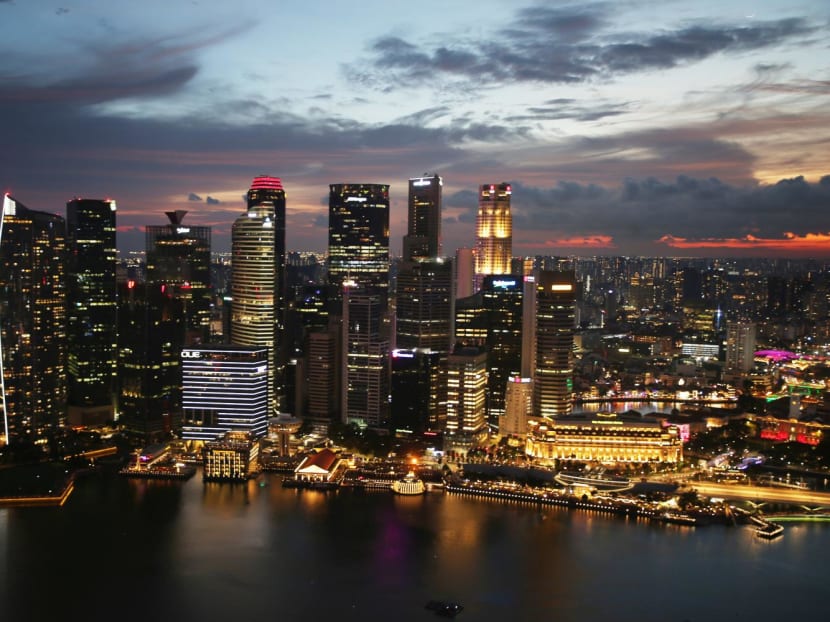News analysis: Raising taxes a 'necessary evil' to cover future higher spending, Govt will face delicate trade-offs, say experts
SINGAPORE — The Government faces some delicate trade-offs if it decides to raise revenue through higher taxes, on top of the Goods and Services Tax (GST) hike, to keep up with increased spending in areas such as healthcare, economists and analysts said.

Though raising taxes might be necessary in the future, the Singapore Government will need to consider the trade-offs involved, experts said.
- A Ministry of Finance released a paper saying that the Government may need to raise more revenue in the years ahead to keep up with higher spending on healthcare and infrastructure, for example
- Economists said that any such increase in revenue, likely via higher taxes, is necessary but also challenging
- This is because there are trade-offs each time the Government wants to raise tax rates, whether it is on income or consumption
- One economist said that any more increase in the Goods and Services Tax, beyond the hike to 9 per cent, could affect political support for the Government as well as households and individuals
- Others said raising taxes on higher-income earners could have an impact on Singapore's ability to attract foreign talent
SINGAPORE — The Government faces some delicate trade-offs if it decides to raise revenue through higher taxes, on top of the Goods and Services Tax (GST) hike, to keep up with increased spending in areas such as healthcare, economists and analysts said.
They were responding to queries from TODAY after the release of an occasional Ministry of Finance (MOF) paper on medium-term fiscal projections on Wednesday (Feb 8). MOF suggested that revenue would need to increase to keep up with such additional spending, on infrastructure projects, for example.
The trade-offs the experts talked about in interviews with TODAY included balancing any possible increase in personal tax for higher-income earners with the need for Singapore to remain attractive to foreign talent as well as weighing any rise in corporate tax against the need to continue to pull in foreign investments.
And should the Government wish to raise the GST beyond the 9 per cent level that it will reach in January next year, it will need to consider the possible political impact on the ruling party, they added.
In the paper, MOF said that government spending is expected to go up from around the current 18 per cent of total economic output, also known as gross domestic product (GDP), to around 19 to 20 per cent in the later half of this decade.
It could even exceed 20 per cent of GDP by 2030, MOF added.
This higher level of government spending as a proportion of the economy is mostly being driven by increased spending in healthcare — as a result of an ageing population — a higher rate of healthcare utilisation, and medical inflation.
Government expenditure is also expected to increase in infrastructure in the form of major, long-term projects such as new MRT train lines.
Another area of higher spending is set to be social support programmes, such as improving early childhood education and uplifting lower-wage workers.
The paper said that the Budget 2022 moves, which included raising the GST from 7 per cent to 9 per cent by 2024, have been necessary to fill the gap between government spending and revenue.
Looking ahead, the Government would have to continue raising revenues to keep up with higher spending, the paper said, though it did not specify which form of revenue.
TODAY spoke to analysts about the potential levers the Government could use to raise revenue, and the tradeoffs that come with them.
POTENTIAL LEVERS TO RAISE REVENUES
Chief economist Selena Ling from OCBC bank said that raising taxes is a “necessary evil” for Singapore if it wants to keep looking after the needs of an ageing population and improve its infrastructure.
“If infrastructure spending lags, then our ability to attract foreign direct investments and talent may suffer in the long run.Chief economist Selena Ling from OCBC”
“If infrastructure spending lags, then our ability to attract foreign direct investments and talent may suffer in the long run,” she said.
“If revenue growth cannot match the spending pace, then something has to give — usually that’s when governments run persistent budget deficits or pile up debts, which could lead to a debt burden on future generations.”
Mr Song Seng Wun, an economist at CIMB bank, said that one option is to raise the GST in the future, in addition to the hike to 9 per cent that will be in place by January 2024.
"It is possible that the Government may raise the GST again some years down, as the GST is reviewed every few years or so,” he added.
“If there is income growth, then people would be able to afford to pay more GST. Singapore’s tax system is progressive that way, in the sense that if you can earn and own more, then you should be able to pay more.”
Personal income tax and corporate income tax are other forms of revenue that could be tapped to increase government revenue and keep pace with spending.
Mr Christopher Gee, a senior research fellow and head of the governance and economy department at the Institute of Policy Studies (IPS), said: “Though personal income tax was increased in 2022, the Government can continue to tax the higher income even more.”
Mr Gee and Mr Irvin Seah, a senior economist at DBS bank, noted that corporate income tax and personal income tax are now Singapore’s largest and second largest sources of tax revenue.
The annual report of the Inland Revenue Authority of Singapore (Iras) for the financial year 2021-2022 showed that corporate income tax accounted for the largest share of taxes collected at 30 per cent or S$18.2 billion, followed by individual income tax at 23 per cent or S$14.2 billion.
“The timing to raise corporate tax and personal income tax will depend on market and business cycles, which is hard to predict,” Mr Seah said.
“Sin” taxes, such as taxes on tobacco and alcohol, are another way that taxes could be increased to raise revenues, Ms Ling said.
“Other options could be increasing stamp duty, property tax, foreign worker levies, and wealth taxes,” she added.
Other potential ways to boost revenue would be to increase the level of funds the Government could draw under the net investment returns contribution (NIRC) arrangement, Ms Ling suggested.
The NIRC framework allows the Government to spend up to 50 per cent of the net investments returns on net assets achieved by Singapore's sovereign wealth fund GIC, the Monetary Authority of Singapore and state investor Temasek Holdings.
It also allows for spending of up to 50 per cent of the net investment income derived from the remaining assets of those past reserves.
The NIRC is one of the largest sources of revenue for government spending, supporting about one-fifth of public expenditure today.
Ms Ling said that the 50 per cent limit could be increased if the Government wanted to to do so to bring in extra revenue.
Another option could be to raise more debt under the Singapore Infrastructure Government Loan Act.
CHALLENGES IN RAISING REVENUE
Though raising taxes might be necessary in the future, the Government will need to consider the trade-offs involved.
“For example, a further increase in GST will have consequences on political support for the Government, and an economic effect on households and individuals,” Mr Gee from IPS said.
“Another example is that if we increase personal income tax for the highest-income earners who are most likely to be highly mobile, they have the choice to work in Singapore or elsewhere, where tax rates are lower.”
Imposing or raising certain forms of a wealth tax could also have the same effect of capital flight, Ms Ling said.
Wealth taxes impose a tax on various forms of financial and physical assets such as property, inheritances, capital gains and luxury cars.
Besides repelling foreign investors and the wealthy, another down side is that the collections from certain forms of wealth tax may be minimal, such that it would not justify the spending on implementing and administrating the tax.
One example is estate tax, which was abolished in 2008. An estate tax imposes a tax on the market value of a person's estate after they die. It is effectively an inheritance tax as the sum left for beneficiaries is reduced.
Iras said that collections from estate taxes made up only 1 per cent of total tax revenue, or S$153.7 million in 2007.
Additionally, then-Finance Minister Tharman Shanmugaratnam said that estate tax disproportionately affected the middle- and upper-middle class instead of targeting the wealthy.
“But some may be willing to pay higher tax rates for Singapore’s reputation as a safe haven, in the context of global geopolitical tensions.Economist Song Seng Wun from CIMB”
Though raising corporate and personal income tax could make Singapore less attractive, Mr Song from CIMB said that some may be willing to pay higher tax rates.
“The wealthier are already paying more, but can they pay even more? I think so. The Government has to find a balance between taxing them and attracting them to live here,” he added.
“But some may be willing to pay higher tax rates for Singapore’s reputation as a safe haven, in the context of global geopolitical tensions.”
Agreeing, economics lecturer Walter Theseira from Singapore University of Social Sciences said that the "main constraint" of raising income and corporate taxes is international competitiveness.
"But if the sense is Singapore is in high demand as a place to do business and work, there is probably some room to boost personal income taxes or corporate income taxes a bit.”
As for "sin" taxes, an increase could affect some businesses here.
In a TODAY commentary, two chairmen of coffee-shop associations urged the Government not to introduce a "drastic increase" to the current excise tax on tobacco and alcohol this year since coffee shops are grappling with rising costs and these are two products that they are heavily reliant on for revenue.
On the suggestion to draw more NIRC above the present spending limit of 50 per cent of the annual investment returns, the Government has explained before why it would not be prudent.
It said that the 50 per cent figure places even emphasis on the needs of today and tomorrow but drawing more for this generation would mean leaving less for the next generation, who would likely end up paying more taxes to fund their needs.
Mr Gee from IPS said that one other factor the Government would need to consider — if it plans to raises taxes in the future to increase revenue — is whether the increase is done at consistent intervals.
“What we don’t want to do is imposing higher taxes without consistency. Ideally, you want a tax system that is stable, predictable and efficient,” Mr Gee said.











